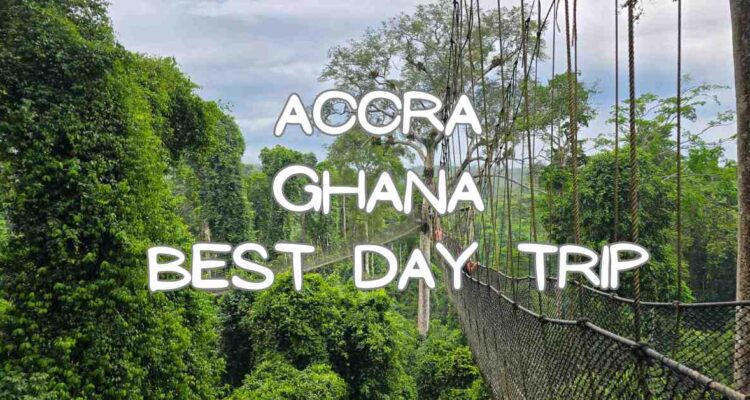Imagine a day trip that intertwines the harrowing truths of the past with the beauty of nature in the present. This Cape Coast Tour from Accra, Ghana, offers just that. We embark on a journey that confronts the legacy of the transatlantic slave trade through two of Ghana’s most significant historical sites – Cape Coast Castle and Elmina Castle.
The afternoon brings a shift in mood as we delve into the verdant rain-forest of Kakum National Park, where a thrilling canopy walk awaits.
Overall this is quite a long day trip, starting at 08:00, when you are picked up at your hotel in Accra. The day ends between 20:00 and 21:00. Even though, this was a long day, we thoroughly enjoyed it and recommend this Cape Coast Tour very highly. Below we also share a travel hack of how we save considerably on this many other Viator tours.
Confronting the Dark Past: Ghana’s Cape Coast Castle and Elmina Castle
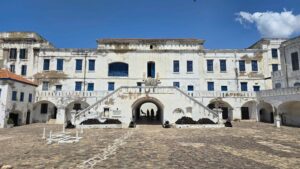
Ghana, along with much of West Africa, played a central role in the transatlantic slave trade, a period of unimaginable brutality that spanned four centuries. European powers, primarily Portugal, Britain, and the Netherlands, established a network of trading posts along the West African coast. These posts served as a chilling point of departure for millions of Africans who were captured, enslaved, and forced onto ships bound for the Americas.
The estimated number of Africans stolen from their homes and shipped across the Atlantic is staggering. Historians believe the figure could be anywhere from 12.5 million to 20 million people. The human cost of this trade was immeasurable, as families were torn apart, cultures were shattered, and countless lives were lost.
Cape Coast Castle: A Poignant Symbol of Suffering
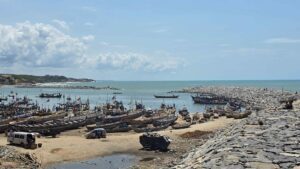
Our first stop was Cape Coast Castle, a UNESCO World Heritage Site that stands as a stark reminder of this dark chapter in history. Built by the Portuguese in the 15th century, the castle was later expanded by the British. As we walk through its imposing walls, a sense of solemnity washes over us. The knowledgeable guides paint a vivid picture of the castle’s operations, from the arrival of terrified captives to their brutal confinement in the dungeons and slave chambers.
The “Door of No Return,” a narrow doorway leading out to the Atlantic Ocean, evokes a wave of emotions. This doorway wasn’t just an exit; it was a point of no return for countless Africans who were forced onto ships, never to see their homeland again. Standing on the very ground where millions were held captive is a humbling experience. The air seems heavy with the weight of history.
A Connection to the Past: Michelle Obama’s Roots
Cape Coast Castle holds a particular significance for many African Americans. In 2009, then-First Lady Michelle Obama visited the castle, tracing her ancestry back to a village not far from the cape. Her visit resonated deeply with the African diaspora, highlighting the enduring impact of the slave trade on families and communities across the Atlantic.
Elmina Castle: A Legacy of Oppression
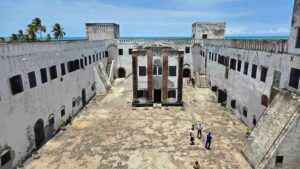
Our journey continued to Elmina Castle, another UNESCO World Heritage Site. Built by the Portuguese even earlier than Cape Coast Castle (in 1482), Elmina is the oldest European structure in sub-Saharan Africa. Stepping inside, we found ourselves immersed in a similar atmosphere of oppression. The castle’s layout mirrors that of Cape Coast Castle, with its dungeons, slave chambers, and “Door of No Return.”
The “Elmina Dungeon” is a particularly chilling reminder of the horrors inflicted upon enslaved Africans. This cramped, airless space housed hundreds of captives in appalling conditions. Disease, malnutrition, and despair were rampant, and the mortality rate within the dungeon walls was undoubtedly high.
Kakum National Park: A Paradise of Lush Rainforests
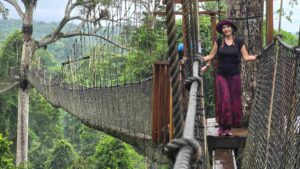
After the emotionally charged morning spent confronting Ghana’s slave trade history, a delicious lunch awaited us at Kakum National Park. Surrounded by the verdant jungle of the rain-forest, we enjoyed freshly prepared Ghanaian dishes. They even had a vegan option for me and our friend which consisted of rice and a peanut sauce with beans.
Kakum National Park, established in 1938, encompasses over 300 square kilometers of pristine rainforest. This protected area is home to a staggering diversity of plant and animal life, making it a haven for nature lovers and eco-tourists. Over 300 bird species, including hornbills, parrots, and touracos, call Kakum their home. Mammals like primates, forest antelopes, and even forest elephants can also be found here.
However, due to the tourists, many of the more elusive (and most interesting) animals have been pushed to the northern part of the park. This is the part that we did not visit, as this area requires a special permit and additional time to visit.
Thrilling Adventure Awaits: The Kakum Canopy Walkway

The afternoon’s highlight is the park’s most thrilling feature – the canopy walkway. This is no ordinary stroll in the park! Imagine walking amongst the treetops, enjoying an unparalleled perspective of the rainforest’s rich flora and fauna.
The Kakum Canopy Walkway is a series of seven suspension bridges, totaling 500 meters in length, suspended a whopping 30 meters above the forest floor. This network of canopy walkways allows visitors to ascend into the heart of the rainforest, offering a breathtaking perspective of the sprawling wilderness.
From this elevated vantage point, you can spot a kaleidoscope of birds flitting between the branches, their vibrant plumage a stark contrast to the emerald foliage. Troops of monkeys swing playfully through the trees, and if you are lucky enough, you just may spot them.

As you traverse the walkways, continue keeping an eye out for Ghana’s unique wildlife. Perhaps you’ll catch a glimpse of a shy bongo antelope grazing in a sunlit clearing, or a troop of elegant black and white colobus monkeys sunning themselves on a high branch. Birdwatchers will delight in the opportunity to spot colorful species like the grey parrot, the western bluebill, and the dazzling African pygmy falcon.
Beyond the spectacle of the wildlife, the rain forest offers a profound sense of tranquility. Inhaling the fresh, crisp air invigorated our senses, leaving us feeling rejuvenated and connected to nature’s raw beauty.
Day Trip Travel Hack to Save Money
One can book this day trip through Viator and spend $250 USD per person for the day. However, if you follow our travel hack, you may be able to purchase this excursion and many other trips at a much lower cost. We actually only paid $112.50 USD per person!
First step (if you have a American Express Credit Card – AMEX) is to check to see if there are any AMEX offers for trips through Viator (they are often available). Then, by going through the Rakuten cashback portal, we saved an additional 10%. Of course if you are booking this while already abroad, make sure that you are using your VPN.
Wrap Up – Accra Cape Coast Tour

For us, this day trip was a journey through history and nature. We learned about the shameful history of Ghana’s slave castles and got to experience the thrill of the country’s gorgeous rain-forest canopy in Kakum National Park.
This journey through Ghana has encompassed the weight of history and the vibrancy of nature. From the somber slave castles to the exuberant rain-forest canopy, it offers a profound appreciation for the country’s complex past and its rich natural heritage.
In some ways, this trip reminded us of our 2 day trip in Gabon. What about you, have you traveled through West Africa? What was your favorite part? We would love to hear from you in the comments.

